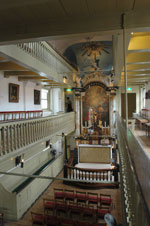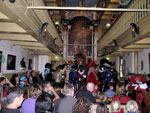Our Lord in the Attic: A Case Study
Our Lord in the Attic: a case study - Teachers' notes
This case study is a result of a collaborative research project of the Getty Conservation Institute (GCI), the Netherlands Institute for Cultural Heritage (ICN) and Museum Ons’ Lieve Heer op Solder (‘Our Lord in the Attic’). It is part of the Preventive Conservation Case Studies project of the GCI Education and Science departments.
This preventive conservation case study is aimed at academic programs in conservation, museum studies, and architecture, as well as mechanical engineering and environmental studies. The case will provide an important opportunity for students to explore the complexities involved in weighing options and making decisions, while exposing them to other professionals' areas of expertise. It can guide students and professionals in decision-making and strategies for historic house museums relating to the subject of visitor impact.
Project background
The first of the GCI case studies deals with preventive conservation in the context of a rather remarkable historic house museum. In the old city center of Amsterdam lies Museum Ons’ Lieve Heer op Solder (Our Lord in the Attic), a house museum with an unusual name and history. On the outside it appears to be an ordinary seventeenth-century Amsterdam canal house. Inside it holds an unusual surprise - a Catholic church in its attic.
In a collaborative project, the GCI and the Netherlands Institute for Cultural Heritage (ICN) - working with the museum’s director Judikje Kiers and her staff - studied the impact of visitors on the indoor environment of the building, its interiors, and its collections. As part of this work, options for management of the indoor environment are also being researched, in which visitor comfort is balanced with creating safe conditions for the preservation of the building and its contents.
The main objectives of the collaborative research project were:
- to document the historic use of the property to be used as a fundament for decision making; to analyze the past and current climate and relate the results to collection risks;
- to analyze the influence of the frequency and number of visitors on the environment of the collection, building and the preservation of important values;
- to create a didactic case study designed to illustrate the interrelated issues affecting the practice of preventive conservation and the decision-making process.
The data and information generated by this research project has been made available in the case study web site, which can be seen as a didactic resource.
Learning objectives
In teaching preventive conservation, real-life examples are of great value. They expose students to the range of issues that must be considered when developing preventive conservation and management strategies for museum collections, buildings, and other cultural sites. The stakeholders involved in the decision making bring different kinds of expertise, experiences, and arguments to the table - all of which have to be taken into consideration if preventive conservation strategies are to be successful and sustainable. There is not just a single approach to preventive conservation.
This particular case study investigates the tension between opening a historic building to the public and the impact of visitors on the building, its interiors and the collections housed within – with special attention given to the use of the building and its contents in its original function. Like many historic house museums, Museum Our Lord in the Attic’s mission requires it to balance preservation with access. However, increasing visitation levels have challenged efforts for both conservation and visitor enjoyment of the museum. Example are the wear and tear on original wooden floors and stairs caused by visitor movement through the building, as well as the increased risks of unintentional damage to and theft of objects, which are on open display in the period rooms. Increasing visitor levels have challenged conservation efforts on the one hand, but also threatened visitor enjoyment as rooms, hallways, and stairs in the building are relatively small and readily feel cramped.
The museum expressed concerns for the indoor climate and how it affects the collection and the building. Should improvements be made, and how can visitor comfort be balanced with appropriate climate conditions for safekeeping the collection? In summer months - and especially during events in the church - indoor temperatures rise and visitors feel uncomfortable. In winter, severe condensation often occurs on the inside of the windows.
The museum aims to keep alive the cultural and religious heritage of Catholic Amsterdam through care of the building and its associated collection. In addition, it wants to be a hospitable and inspiring meeting place where visitors can reflect upon and share their own religious and spiritual experiences. The museum’s director recognizes that the Our Lord in the Attic museum has an important role to play in current discussions of religious understanding and tolerance (more information about the make-up of Dutch society can be found on the Statistics Netherlands web site). For this reason, visits to this unique cultural site will likely increase in coming years, making it all the more necessary to determine a conservation and visitor management policy that supports the interpretation goals of the museum.



